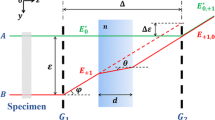Abstract
Crack-opening interferometry is a technique whereby one can directly measure the normal opening displacement of a crack that exists in a transparent material. Here, wer extend the techique to situations in which the crack lies along the interface between a stransparent material and a highly reflective metal. We discuss how the intensity distribution and the placement of the fringes vary with reflectivity of the metal. However, because the fringe spacing is not affected, the fringes can still be interpreted in terms of normal crack-opening displacement profile. The paper reports experimental measurements of crack-opening displacement profile of an interface crack in a copper-sapphire bircystal. The results show the crack-opening displacement profile to be that of a constant opening angle.
Similar content being viewed by others
References
Liechti, K.M., “On the Use of Classical Interferometry Techniques in Fracture Mechanics,”Experimetal Techniques in Fracture, J.S. Epstein, ed, VCH, New York Chap 4 (1993).
Swadener, J.G. andLiechti, K.M., “Asymmetric Shielding Mechanism in the Mixed-mode Fracture of a Glass/epoxy Interface,”J. Appl. Mech.,65,25–29 (1998).
Born, E. andWolf, E., Principles of Optics, Pergamon Press, Oxford (1993).
Palik, E.D., Handbook of Opitcal Constants of Solids, Academic Press, Boston (1991).
Fowlkes, C.W., “Crack Opening Interferometry—The Effects of Optical Refraction,”Eng. Fract. Mech.,7,689–691 (1975).
Liang, Y.-M. andLiechti, K.M., “Toughening Mechanisms in Mixed-mode Interfacial Fracture,”Int. J. Solids Struct.,32,957–978 (1995).
Kysar, J.W., “Effects of Strain Field on Light in Crack Opening Interferometry,”Int. J. Solids Struct.,35,33–49 (1998).
Kysar, J.W., “Path of Light in Near Crack Tip Region under Mixed-mode Loading and in Anisotropic Medium,” Int. J. Solids Struct. (in press).
Kysar, J.W., “Directional Dependence of Fracture in Copper/sapphire Bicrystal,”Acta Mat.,48,3509–3524 (2000).
Kysar, J.W., “Continuum Simulations of Directional Dependence of Crack Growth along a Copper/sapphire Bicrystal Interface: Part I,” J. Mech. Phys. Solids (in press).
Kysar, J.W., “Continuum Simulations of Directional Dependence of Crack Growth along a Copper/sapphire Bicrystal Interface: Part II,” J. Mech. Phys. Solids (in press).
McClintock, F.A. andIrwin, G.R., “Plasticity Aspects of Fracture Mechanics,”ASTM STP, 381, American Society for Testing and Materials, Philadelphia, 84–113 (1965).
Rice, J.R., “Elastic-plastic Crack Growth,”Mechanics of Solids, H.G. Hopkins andM.J. Sewell, eds., Pergamon Press, Oxford, 539–562 (1982).
Neumann, P., “New Experiments Concerning the Slip Processes at Propagating Fatigue Crack—I,”Acta Metall.,22,1155–1165 (1974).
Green, G. andKnott, J.F., “On Effects of Thickness on Ductile Crack Growth in Mild Steel,”J. Mech. Phys. Solids,23,167–183 (1975).
Ma, F., Deng, X., Sutton, M.A., andNewman, J.C., Jr., “A CTOD-based Mixed-mode Fracture Criterion,”ASTM STP 1359, American Society for Testing and Materials, Philadelphia, 86–110 (1999).
Author information
Authors and Affiliations
Additional information
when work was performed. Current affiliation is as Research Associate, Division of Engineering, Brown University, Providence, RI 02912.
Rights and permissions
About this article
Cite this article
Kysar, J.W. Crack-opening interferometry at interfaces of transparent materials and metals. Experimental Mechanics 41, 52–57 (2001). https://doi.org/10.1007/BF02323104
Received:
Accepted:
Issue Date:
DOI: https://doi.org/10.1007/BF02323104




